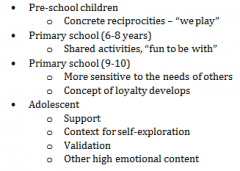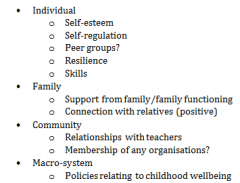![]()
![]()
![]()
Use LEFT and RIGHT arrow keys to navigate between flashcards;
Use UP and DOWN arrow keys to flip the card;
H to show hint;
A reads text to speech;
55 Cards in this Set
- Front
- Back
|
What is separation anxiety disorder? |
Developmentally inappropriate and excessive fear or anxiety concerning separation from those to whom the individual is attached |
|
|
What are some criteria of separation anxiety disorder? |
- Persistent worry about losing major figure - Persistent fear of being left without major figure - Distress when separating from major figure |
|
|
What are some neurodevelopmental disorder? |
- Attention-Deficit and Disruptive Behaviour Disorders - Intellectual disability - Specific learning disorder - Autism Spectrum Disorder - Global Developmental Delay - Tic disorders |
|
|
What is the prevalence rate of ADHD? |
5% |
|
|
What is ADHD? |
- Inattention: difficulty completing tasks, easily distracted - Hyperactivity-impulsivity: fidgeting or squirming, talking excessively, difficulty remaining still |
|
|
What are some risk factors of ADHD? |
- Child temperament - Low socioeconomic status - Families with high levels of conflict |
|
|
What are some of the concerns regarding ADHD diagnosis? |
- Environmental variables - Questions regarding the meaning of the diagnosis locating the problem within the child - Questions regarding treatment, particularly the prescription of stimulant medication - Issues around definition of ‘hyperactivity’ |
|
|
What is autism spectrum disorder? |
- Social interaction: failure to develop peer relationships, lack of social or emotional reciprocity - Communication: delay in, or total lack of, spoken language, lack of varied, spontaneous make-believe play, delayed language comprehension - Activities and Interests: preoccupation with one or more restricted patterns of interest, inflexible adherence to routines and rituals |
|
|
What is the prevalence of autism? |
1% |
|
|
Why do we need a separate criteria for girls? |
Girls pick up on social cues and thus may not manifest symptoms in the same way |
|
|
What is the HPA axis? |
Feedback between interactions between the hypothalamus, pituitary gland, and adrenal glands |
|
|
Why is the HPA axis important? |
Plays a strong role in stress (cortisol). Early environmental stressors may change a child’s neurochemistry |
|
|
What are telomeres? |
Telomeres are long repetitive regions of nucleotides at the end of each chromosome. Along with the enzyme telomerase, they protect the ends of chromosomes from degrading or fusing with other chromosomes |
|
|
How does stress effect telomeres? |
Telomere length appears to be related to stress and telomeres are shorted in children who have been raised in “stressful environments” |
|
|
What is important when working with children? |
- Good rapport, particularly when doing any sort of testing, interview or assessment - Patience - Ability to understand potential meanings of disruptive behaviour or inattention (i.e. doesn’t just mean the child is being ‘naughty’) - Particularly important if doing any form of assessment |
|
|
What is play therapy? |
Children can be guided towards attaining particular forms of play that increase the likelihood of a positive sense of self, or which can address/repair challenging behaviours
Treats the observes of everyday play as providing insight into the internal world of the child |
|
|
What is SMART? |
Strategies for managing abuse related trauma |
|
|
What are the prinicples of SMART? |
- Predictive: change is a threat – continuity is important - Responsive: children who have experiences trauma have typically done so at the hands of those not able to see what their impact is - Attuned: children who have experienced trauma often feel that people can’t/don’t see what they need - Connecting: a lack of connections with others often means for children a lack of trust in themselves - Translating: children who have experienced trauma often cannot narrate themselves/their lives - Involving: children who have experienced trauma often cannot connect to others and need support in doing so and being able to perceived - Calming - Engaged |
|
|
What is applied behaviour analysis for autism spectrum disorder? |
- Intense, early intervention program - Focuses on behaviour modification o Remember back to behaviourism - Uses operant conditioning o Reinforcements (rewards/removal of positive responses for unwanted behaviour) |
|
|
Who is the founder of behaviourism? |
John Watson |
|
|
What is behaviourism? |
The theory that all behaviour can be explain without the need to consider internal factors. Focus on external factors |
|
|
What is Albert Bandura's social learning theory? |
He argued that people learn from on another via observation, imitation, and modelling |
|
|
What do socio-cognitive theories focus on? |
- Focus on children’s abilities to think and reason about their own and other people’s thought, feelings, motives, and behaviours - Recognition that children are active social thinkers |
|
|
What are the stages in Selman's theory? |
- Stage 1 (6-8): Appreciate that other have different perspective- assume person doesn’t have the same information - Stage 2 (8-10): Can also think about the other person’s point of view - Stage 3 (10-12): Systematic comparison of views of self and one or two others - Stage 4 (12 and up): Attempt to understand others’ perspective through comparison with ‘generalised other’ (abstract) |
|
|
What are the critiques of socio-cognitive theories? |
- Social cognitive theories have made important contributions - However- incomplete account due to little focus on biological factors in development |
|
|
What are the ecological perspectives? |
Evolutionary and ethological, and bio-ecological |
|
|
What are the evolutionary and ethological perspectives? |
Perspectives relate children’s development to evolutionary history Children as inherits of genetically-based abilities and predispositions that underlie most aspects of their behaviour – especially those with an adaptive function |
|
|
What is the bio-ecological perspective? |
Bio-ecological perspectives emphasise children’ active role in selecting and influencing the environments |
|
|
What is Brofenbrenner’s bio-ecological model of development? |
- Microsystems: Immediate, bi-directional environment - Mesosystem: Connections between various microsystems - Exosystem: Environmental settings that the person does not directly experience but which can influence the child indirectly: e.g. the media - Macrosystem: Larger cultural context - Chronosystem: Historical changes that influence other systems |
|
|
What are the functions of families? |
- Survival of offspring: make sure children survive until adulthood - Economic function: provide the means for children to acquire skills to become economically productive in adulthood - Cultural function: teach children basic values of the culture |
|
|
What are the four parenting styles? |
- Authoritarian: high demandingness, low responsiveness - Rejecting-Neglecting: low demandingness and responsiveness - Permissive/Indulgent: low demandingness, high responsiveness - Authoritative: high demandingness and responsiveness |
|
|
What are some causes of maltreatment? |
- Characteristics of parent - Characteristics of child: Remember need to develop mutual regulation/reciprocal communication for level 1 - Factors in environment – i.e. meso and exo systems |
|
|
What are some implications of maltreatment? |
- Social isolation
- Impact on interaction skills and peer relationships - Coping mechanisms - Aggression - Behavioural issues (adaptive responses) - Physical injuries - Attachment - Lower self-esteem - Higher rates of mental health issues – difficult to do research/claiming causality |
|
|
What are two notions of friendship? |
- Reciprocity (but not necessarily an even exchange) - Mutuality (shared liking and preference to spend time together) |
|
|
When is the first observation of peer preferences? |
12 to 18 months |
|
|
What happens with friendship at 20 months? |
- Initiation of more interactions with some children rather than others - Contribute more in games with them |
|
|
What are the characteristics of the beginnings of friendships? |
- Pretend play - Shared understanding - Higher rate of conflict but more likely to resolve it |
|
|
What are the developmental benefits of friendships? |
- Understanding and moderating emotions - Elaborating and developing ideas - Problem solving - Enhancing creativity - Protective buffer against bullying/teasing - Complexity of play |
|
|
What are the changes to friendship with age? |

|
|
|
What are some long term benefits of friendship? |
Reciprocated friendships at grade 5 can predict: -More success academically and in family and social life at age 23 - Lower incidence of problems with the law - Less mental health issues - Greater feelings of self-worth in adulthood |
|
|
How can friendships increase resilience? |
- Good quality friendships may compensate for poor family socialisation - Friendship may provide a buffer for family stress/breakdown - Having a good friend buffers against social isolate or victimisation |
|
|
What are some pro-social behaviours? |
Empathy and sympathy |
|
|
What is the definition of aggression? |
Defined as behaviour that is intended to harm others |
|
|
What are the two classes of agression? |
Reactive and proactive |
|
|
What are some social influences on aggression? |
- Punitive parenting, especially abuse - Parental conflict - Inconsistent parenting - SES - Media violence - Peers |
|
|
What are the developmental stages of aggression? |
- Emerges from about 18 months - Tends to be instrumental – goal directed - Physical aggression peaks about 2 years and decreases thereafter as verbal skills increase, as well as better emotional control - Use of aggression relatively stable after about ag 10 |
|
|
What are the definitions of bullying? |
- Behaviour that is intentionally negative or hurtful to others - An imbalance of power - Repeated and unfair attacks - Overt or covert (physical, verbal or social, relational) |
|
|
What is overt bullying? |
Direct physical aggression: hitting, kicking, intimidation, theft, destruction of property Direct verbal aggression: name calling, jeering, teasing, threats |
|
|
What is covert bullying? |
- Social exclusion and isolation - Rejection - Rumour spreading - “Stealing” friends - Directed towards damaging self-esteem and/or social status |
|
|
What are the impacts of bullying? |
- Loss of self-esteem - Psychological problems including loneliness - Absenteeism, poor school performance |
|
|
What is involved with empowerment for victims of bullying? |
- Understanding and dealing with feelings - Recognition of reasons for bullying - Building self-esteem - Developing confident communication skills - Social supports - Management strategies |
|
|
What are some interventions for bullies? |
- Reactive bullying – attribution re-training o Investigation of family factors - Intervention with parents? - Modelling social concern, promotion of pro-social behaviour - Consistent consequences for bullying behaviour |
|
|
What are some risk factors of childhood wellbeing? |

|
|
|
What are the indicators of resilience? |
- Education (including of parents) - Positive social networks - Adequate emotional expression - Supportive family and peer relationships |
|
|
What are some protective factors of childhood wellbeing? |

|

